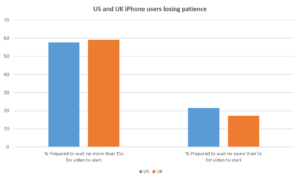Mobile Video Buffering is the Biggest Annoyance for iPhone Users
Almost 60% of iPhone users will wait no more than 15 seconds for a video to load
REDWOOD CITY, Calif. –September 4, 2015 – Independent research commissioned by Openwave Mobility has found that poor mobile video streaming is an even bigger headache than a dropped call for iPhone users. Over 2,000 iPhone users in the UK and US were interviewed ahead of the new iPhone launch on 9th September to study people’s mobile video habits. With mobile video growing at a phenomenal rate, iPhone users’ tolerance to video-buffering is rapidly disappearing. Over half (59%) of subscribers in both countries will abandon streaming a mobile video if they have to wait longer than 15 seconds. The British and American survey which was conducted by research agency Censuswide, found that nearly a fifth (19%) will abandon a video after only a 5 second wait.
With another large screen iPhone in the offing, subscribers are coming to expect seamless quality in the delivery of content and in particular video. In both countries almost 1/3 of subscribers (31%) expressed a strong view that video buffering is simply unacceptable, and video delivery by mobile operators is lagging behind the latest handset technology that is driving the industry forward.
The growing importance of Snapchat, Vine and Instagram to a younger audience was also confirmed in the survey with Millennials predictably unwilling to wait for short-form video content to load. For their parents, the Baby Boomer generation, it was the reverse. Long form video was more important to them as they catch up on the previous night’s television or an episode of their favorite series on their iPhone, and this, older generation also exercised more patience.
A similar figure in both geos, 39%, said they would pay extra dollars if the operator could only provide some assurance on the quality of video delivery. And, most telling of all, when it came to the blame game the study found that 1 in 2 customers blame the carrier for poor mobile video service and 1 in 3 blame Apple. Notably almost nobody blames the content providers or the Over The Top (OTT) players.
“With 39% of US and UK iPhone customers happy to pay more for a better mobile video experience, operators are leaving money on the table,” said John Giere, President and CEO of Openwave Mobility. “Put simply, the operators working in conjunction with the industry need to improve the mobile video experience, or they will watch customers churn to competitors.”
Joe Hoffman, Vice President Strategic Technology at ABI Research adds: “Mobile operators should take Openwave Mobility’s findings seriously. Our research shows that 70% of operators worldwide do not have a coherent web and video optimization strategy. If just one-third of operators implemented solutions such as Openwave Mobility’s, then the combined effect over the next five years from churn and CapEx reduction with ARPU elevation would move the needle US$ 30 billion into the black.”

A more detailed breakdown of the survey of iPhone users can be found here.
About Openwave Mobility
Openwave Mobility empowers mobile operators to manage and monetize video traffic using the industry’s most scalable, Layer7 SDN/NFV platform. Openwave Mobility delivers Video Optimization, Subscriber Data Management and Targeted Ad Insertion. Together these eliminate RAN congestion, maximize value from subscriber data and create new revenue opportunities.
Openwave Mobility delivers over 40 billion transactions daily and over half a billion subscribers worldwide use data services powered by its solutions. The company’s global customer base consists of over 40 of the largest communication service providers including AT&T, Du, KDDI, Rogers, Sprint, Telus, T-Mobile, Telstra, Orange, Meditel and Sasktel. Openwave Mobility is owned by Marlin Equity Partners, a leading investment firm with over a billion dollars of capital under management that has publicly committed to building the company through expanded investment in R&D. The company has built a robust portfolio of Intellectual Property, which is growing month by month.
# # #